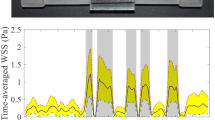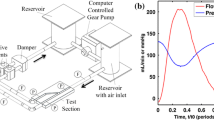Abstract
Asymmetric 75% and 95% area reduction, transparent Sylgard stenotic models were operated under internal carotid artery (ICA) (Womersley parameter, α=5.36, Remean=213 and 180, respectively, and Repeak=734 and 410, respectively) and left anterior descending coronary artery (LAD) flow wave forms (α=2.65,Remean=59 and 57, respectively, and Repeak=137 and 94, respectively) to evaluate the effect of these conditions on particle residence times downstream of the stenoses. Amberlite particles (1.05 g/cm3, 400 μm) were added to the fluid to simulate platelets and their motion through the stenotic region and were traced using a laser light sheet flow visualization method with pseudo-color display. Two-dimensional (2D) particle motions were recorded and particle washout in the stenotic throat and downstream section were computed for all cases. All four model cases demonstrated jetting through the stenosis which followed an arching pattern around a large separation zone downstream. Considerable mixing was observed within these vortex regions during high flow phases. Particle washout profiles showed no clear trend between the degrees of stenosis although particles downstream of the stenoses tended to remain longer for LAD conditions. The critical washout cycle (1% of particles remaining downstream of the stenosis), however, was longer for the 95% stenoses cases under each flow condition due to the larger protected region immediately downstream and maximal for the LAD 95% case. Results of this study suggest that particle residence times downstream of 75% and 95% stenoses (~ 3–6 s for ICA and ~ 8–10 s for LAD) exceed the minimum time for platelet adhesion (~ 1 s) for at least 1% of cells and, thus, may be sufficient to initiate thrombus formation under resting conditions. © 1998 Biomedical Engineering Society.
PAC98: 8745Hw, 8722-q, 4727Wg, 4732Cc
Similar content being viewed by others
REFERENCES
Adams, P. C., V. Fuster, L. Badimon, J. J. Badimon, and J.H. Chesebro. Platelet/vessel wall interactions, rheological factors and thrombogenic substrate in acute coronary syndromes: Preventive strategies. Am. J. Cardiol. 60:9G-16G, 1987.
Berne, R. M., and M. N. Levy. Cardiovascular Physiology, 4th ed. St. Louis, MO: Mosby, 1981.
Boreda, R., R. S. Fatemi, and S. E. Rittgers. Potential for platelet stimulation in critically stenosed carotid and coronary arteries. J. Vasc. Invest. 1:26-37, 1995.
Colantuoni, G., J. D. Hellums, J. L. Moake, and C. P. Alfrey,Jr. The response of human platelets to shear stress at short exposure times. Trans. Am. Soc. Artif. Intern. Organs 23:626-630, 1977.
Davies, M. J., and A. C. Thomas. Plaque fissuring—the cause of acute myocardial infarction ischaemic death, and crescendo angina. Br. Heart J. 53:363-373, 1985.
Falk, E. Plaque rupture with severe pre-existing stenosis precipitating coronary thrombus: Characteristics of coronary atherosclerotic plaques underlying fatal occlusive thrombi. Br. Heart J. 50:127-134, 1983.
Folts, J. D., E. B. Crowell, Jr., and G. G. Rowe. Platelet aggregation in partially obstructed vessels and its elimination with aspirin. Circulation 54:365-370, 1976.
Folts, J. D., K. Gallagher, and G. G. Rowe. Blood flow reductions in stenosed canine coronary arteries: Vasospasm or platelet aggregation? Circulation 65:248-255, 1982.
Fry, D. L. Acute vascular endothelial changes associated with increased blood velocity gradients. Circ. Res. 22:165-197, 1968.
Gear, A. R. L. Platelet adhesion, shape change, and aggregation: Rapid initiation and signal transduction events. Can. J. Physiol. Pharm. 72:285-294, 1994.
Goldsmith, H. L., and T. Karino. Quantitative cardiovascular studies: Clinical and research application of engineering principles. Baltimore: University Park Press, 1978, pp. 289-351.
Gould, K. L., K. Lipscomb, and G. W. Hamilton. Physiologic basis for assessing critical coronary stenosis. Am. J. Cardiol. 33:87-94, 1974.
Haerem, J. W. Sudden coronary death: The occurrence of platelet aggregates in the epicardial arteries of man. Atherosclerosis 14:417-432, 1971.
Hawiger, J. Formation and regulation of platelet and fibrin hemostatic plug. Human Pathology 18:111-122, 1987.
Hellums, J. D., D. M. Peterson, N. A. Stathopoulos, J. L. Moake, and T. D. Giorgio. Studies on the mechanisms of shear-induced platelet activation. In: Cerebral Ischemia and Hemorheology, edited by A. Hartmann and W. Kuschinsky. Berlin: Springer-Verlag, 1987, pp. 80-89.
Herrmann, R. G., and W. B. Lacefield. Effect of antithrombotic drugs on in vivo experimental thrombosis. In: Platelets, and Thrombosis, edited by S. Sherry and A. Scriabine. Baltimore: University Park Press, 1974, pp. 203-221.
Jen, C. J., and L. V. McIntire. Characteristics of shearinduced aggregation in whole blood. J. Lab. Clin. Med. 103:115-124, 1984.
Kajiya, F., G. Tomonaga, K. Tsujioka, Y. Ogasawara, and H. Nishihara. Evaluation of local blood flow velocity in proximal and distal coronary arteries by laser Doppler method. J. Biomed. Eng. 107:10-15, 1985.
Kunov, M. J., D. A. Steinman, and C. R. Ethier. Particle volumetric residence time calculations in arterial geometries. J. Biomed. Eng. 118:158-164, 1996.
Machovich, R., editor. Blood Vessel Wall and Thrombosis, Vol. II, Boca Raton, FL: CRC, 1988.
Rittgers, S. E., and M. C. S. Shu. Doppler color-flow images from a stenosed arterial model: Interpretation of flow patterns. J. Vasc. Surg. 12:511-522, 1990.
Sokal, R. R., and F. J. Rohlf. Biometry, 2nd ed. New York: Freeman, 1980.
Tsao, R., S. A. Jones, D. P. Giddens, C. K. Zarins, and S. Glagov. An automated three-dimensional particle tracking technique for the study of modeled arterial flow fields. J. Biomed. Eng. 117:211-218, 1995.
Vaishnav, R. N., D. J. Patel, H. B. Atabek, M. D. Deshpande, F. Plowman, and J. Vossoughi. Determination of the local erosion stress of the canine endothelium using a jet impingement method. J. Biomed. Eng. 105:77-83, 1983.
Wurzinger, L. J., R. Opitz, P. Blasberg, L. J. Wurzinger, R. Opitz, P. Blasberg, and H. Schmid-Schonbein. Platelet and coagulation parameters following millisecond exposure to laminar shear stress. Thrombosis Haemostasis 54:381-386, 1985.
Author information
Authors and Affiliations
Rights and permissions
About this article
Cite this article
Cao, J., Rittgers, S.E. Particle Motion Within In Vitro Models of Stenosed Internal Carotid and Left Anterior Descending Coronary Arteries. Annals of Biomedical Engineering 26, 190–199 (1998). https://doi.org/10.1114/1.131
Issue Date:
DOI: https://doi.org/10.1114/1.131




